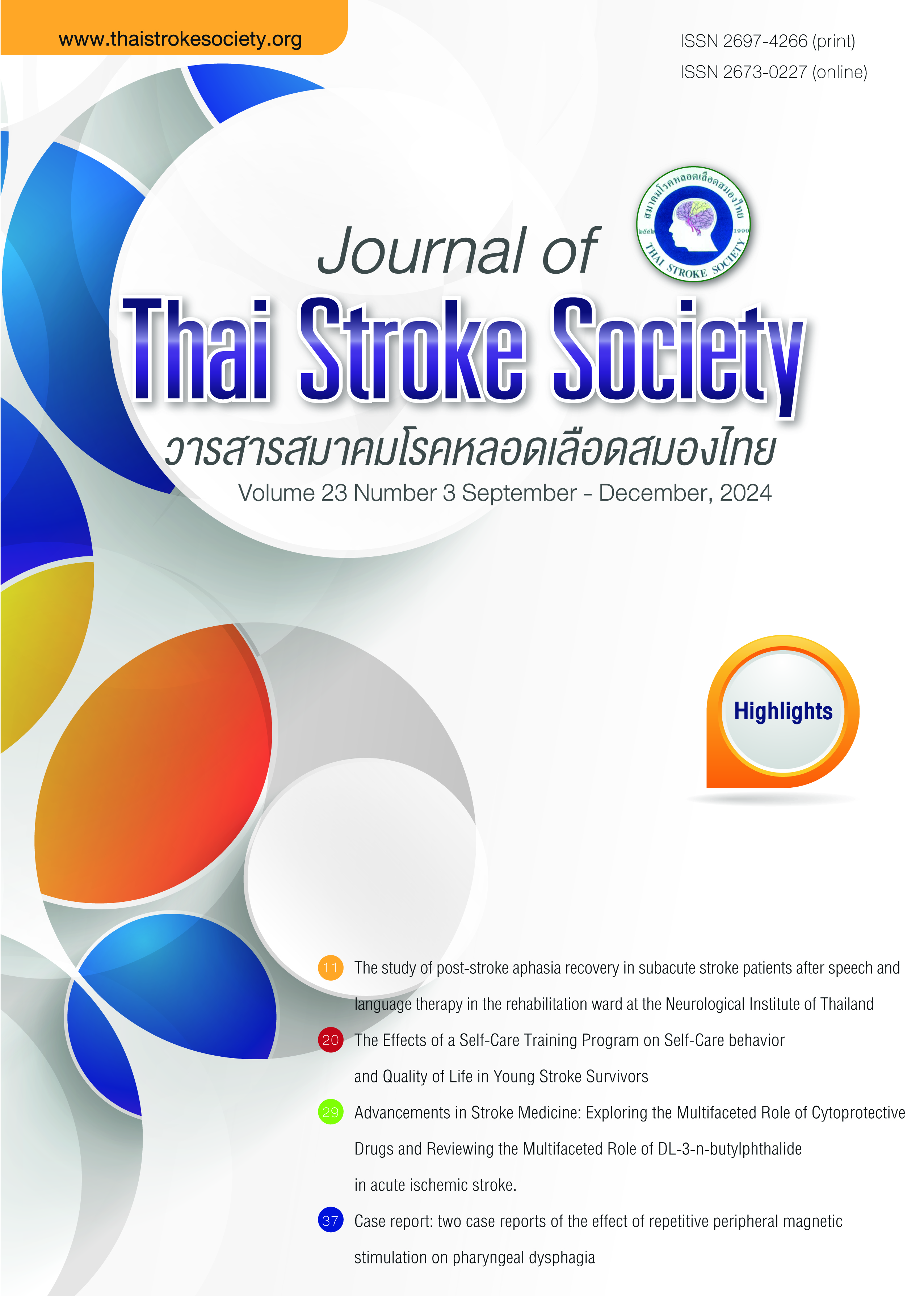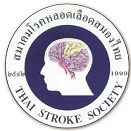Advancements in Stroke Medicine: Exploring the Multifaceted Role of Cytoprotective Drugs and Reviewing the Multifaceted Role of DL-3-n-butylphthalide in acute ischemic stroke.
Keywords:
Cytoprotective drugs, Pleiotropic effect, DL-3-n-butylphthalide (NBP), Ischemic strokeAbstract
In the contemporary landscape of medical science, the treatment of acute ischemic stroke, aiming to restore blood supply to the brain either through thrombolytic agents or endovascular procedures, has achieved significant progress and standardization. In this context, the role of cytoprotective drugs, designed to prevent injury and facilitate brain cell recovery, warrants renewed consideration. Additionally, an understanding of the sequential processes led by ischemic stroke, encompassing various facets of neural damage, such as neuroinflammation, oxidative and nitrosative stress, blood-brain barrier dysfunction, and vasogenic edema, extends beyond neuronal cell injury alone. This broadened perspective underscores the significance of comprehending disease mechanisms and appreciating the potential benefits of cytoprotective drugs in acute ischemic stroke treatment. Particularly, cytoprotective drugs with pleiotropic mechanism of action have emerged as promising candidates. This article provides an overview of cytoprotective drugs and reviews the literature on DL-3-n-butylphthalide, a pleiotropic cytoprotective drug, in the clinical setting. We discuss the mechanisms of action, therapeutic benefits, and precautions in drug administration. Additionally, we explore distinctions between DL-3-n-butylphthalide and other cytoprotective agents, along with pertinent comparative efficacy data for currently used cytoprotective drugs.
References
Goyal M, Menon BK, van Zwam WH, et al. Endovascular thrombectomy after large-vessel ischaemic stroke: a meta-analysis of individual patient data from five randomised trials. Lancet. 2016;387 (10029):1723-1731.
Mulder IA, van Bavel ET, de Vries HE, Coutinho JM. Adjunctive cytoprotective therapies in acute ischemic stroke: a systematic review. Fluids Barriers CNS. 2021;18(1):46.
Savitz SI, Baron JC, Fisher M; STAIR X Consortium. Stroke Treatment Academic Industry Roundtable X: Brain Cytoprotection Therapies in the Reperfusion Era. Stroke. 2019;50(4):1026–1031.
Wang H, Ye K, Li D, Liu Y, Wang D. DL-3-n-butylphthalide for acute ischemic stroke: An updated systematic review and meta-analysis of randomized controlled trials. Front Pharmacol. 2022;13:963118.
Wang A, Jia B, Zhang X, et al. Efficacy and Safety of Butylphthalide in Patients with Acute Ischemic Stroke: A Randomized Clinical Trial. JAMA Neurol. 2023;80(8):851-859.
Yang M, Dang R, Xu P, et al. Dl-3-n-Butylphthalide improves lipopolysaccharide-induced depressive-like behavior in rats: involvement of Nrf2 and NF-κB pathways. Psychopharmacology (Berl). 2018;235(9):2573-2585.
Zheng B, Zhou Y, Zhang H, et al. Dl-3-n-butylphthalide prevents the disruption of blood-spinal cord barrier via inhibiting endoplasmic reticulum stress following spinal cord injury. Int J Biol Sci. 2017;13(12):1520-1531.
Chen XQ, Qiu K, Liu H, He Q, Bai JH, Lu W. Application and prospects of butylphthalide for the treatment of neurologic diseases. Chin Med J (Engl). 2019;132(12):1467-1477.
Tan Z, Zhao Y, Yang W, He S, Ding Y, Xu A. Efficacy and Safety of Adherence to dl-3-n-Butylphthalide Treatment in Patients with Non-disabling Minor Stroke and TIA-Analysis from a Nationwide, Multicenter Registry [published correction appears in Front Neurol. 2021 Nov 23;12:800494]. Front Neurol. 2021;12:720664.
Li F, Ma Q, Zhao H, et al. L-3-n-Butylphthalide reduces ischemic stroke injury and increases M2 microglial polarization. Metab Brain Dis. 2018;33(6):1995-2003.
Xue LX, Zhang T, Zhao YW, Geng Z, Chen JJ, Chen H. Efficacy and safety comparison of DL-3-n-butylphthalide and Cerebrolysin: Effects on neurological and behavioral outcomes in acute ischemic stroke. Exp Ther Med. 2016;11(5):2015-2020.
Zhang H, Wang L, Zhu B, et al. A comparative study of the neuroprotective effects of dl-3-n-butylphthalide and edaravone dexborneol on cerebral ischemic stroke rats. Eur J Pharmacol. 2023;951:175801.
Shah ZA, Namiranian K, Klaus J, Kibler K, Doré S. Use of an optimized transient occlusion of the middle cerebral artery protocol for the mouse stroke model [published correction appears in J Stroke Cerebrovasc Dis. 2009 Mar-Apr;18(2):171]. J Stroke Cerebrovasc Dis. 2006;15(4):133-138.
Powers WJ, Rabinstein AA, Ackerson T, et al. Guidelines for the Early Management of Patients With Acute Ischemic Stroke: 2019 Update to the 2018 Guidelines for the Early Management of Acute Ischemic Stroke: A Guideline for Healthcare Professionals From the American Heart Association/American Stroke Association [published correction appears in Stroke. 2019 Dec;50(12):e440-e441]. Stroke. 2019;50(12):e344-e418.
Xiong Y, Wakhloo AK, Fisher M. Advances in Acute Ischemic Stroke Therapy. Circ Res. 2022;130(8):1230-1251.
Downloads
Published
How to Cite
Issue
Section
License
Copyright (c) 2024 Journal of Thai Stroke Society

This work is licensed under a Creative Commons Attribution-NonCommercial-NoDerivatives 4.0 International License.
ข้อความภายในบทความที่ตีพิมพ์ในวารสารสมาคมโรคหลอดเลือดสมองไทยเล่มนี้ ตลอดจนความรับผิดชอบด้านเนื้อหาและการตรวจร่างบทความเป็นของผู้นิพนธ์ ไม่เกี่ยวข้องกับกองบรรณาธิการแต่อย่างใด การนำเนื้อหา ข้อความหรือข้อคิดเห็นของบทความไปเผยแพร่ ต้องได้รับอนุญาตจากกองบรรณาธิการอย่างเป็นลายลักษณ์อักษร ผลงานที่ได้รับการตีพิมพ์ในวารสารเล่มนี้ถือเป็นลิขสิทธิ์ของวารสาร





